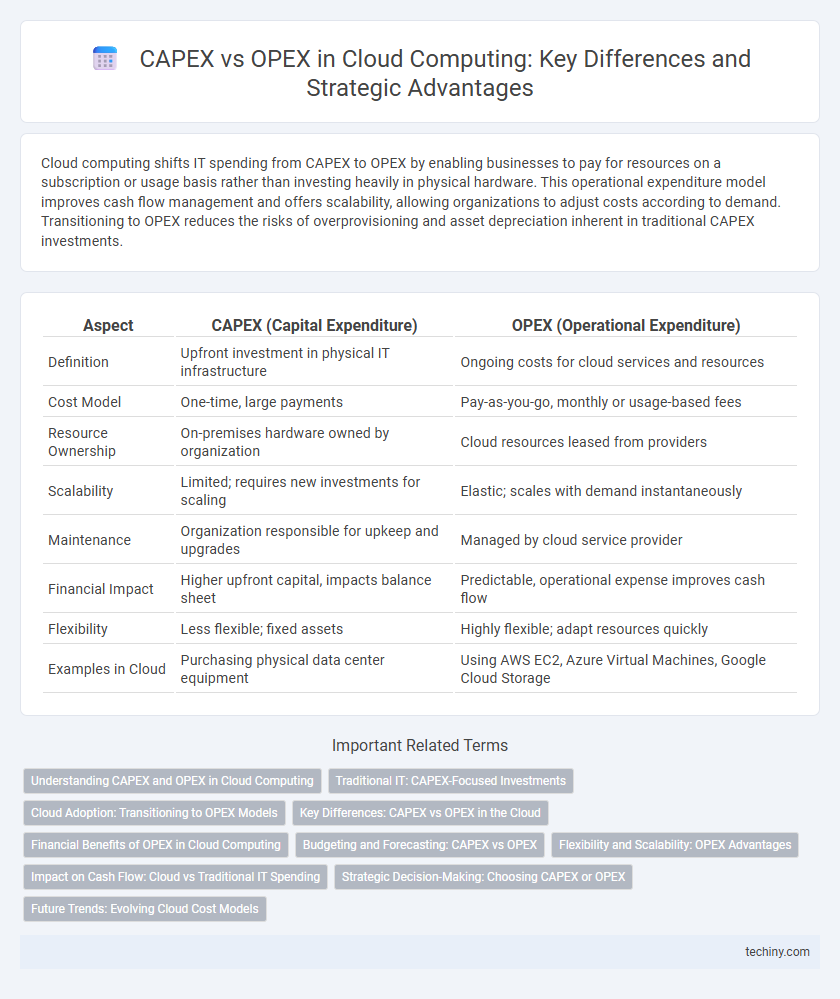Cloud computing shifts IT spending from CAPEX to OPEX by enabling businesses to pay for resources on a subscription or usage basis rather than investing heavily in physical hardware. This operational expenditure model improves cash flow management and offers scalability, allowing organizations to adjust costs according to demand. Transitioning to OPEX reduces the risks of overprovisioning and asset depreciation inherent in traditional CAPEX investments.
Table of Comparison
| Aspect | CAPEX (Capital Expenditure) | OPEX (Operational Expenditure) |
|---|---|---|
| Definition | Upfront investment in physical IT infrastructure | Ongoing costs for cloud services and resources |
| Cost Model | One-time, large payments | Pay-as-you-go, monthly or usage-based fees |
| Resource Ownership | On-premises hardware owned by organization | Cloud resources leased from providers |
| Scalability | Limited; requires new investments for scaling | Elastic; scales with demand instantaneously |
| Maintenance | Organization responsible for upkeep and upgrades | Managed by cloud service provider |
| Financial Impact | Higher upfront capital, impacts balance sheet | Predictable, operational expense improves cash flow |
| Flexibility | Less flexible; fixed assets | Highly flexible; adapt resources quickly |
| Examples in Cloud | Purchasing physical data center equipment | Using AWS EC2, Azure Virtual Machines, Google Cloud Storage |
Understanding CAPEX and OPEX in Cloud Computing
Capital Expenditure (CAPEX) in cloud computing refers to the upfront costs associated with purchasing and maintaining physical hardware, while Operational Expenditure (OPEX) encompasses the ongoing expenses such as subscription fees, maintenance, and support services for cloud resources. Cloud adoption shifts many IT costs from CAPEX to OPEX by enabling pay-as-you-go models, reducing the need for large initial investments in infrastructure. Understanding this financial distinction helps organizations optimize budgets, enhance scalability, and improve cash flow management in cloud-based environments.
Traditional IT: CAPEX-Focused Investments
Traditional IT infrastructure relies heavily on CAPEX-focused investments, requiring upfront capital expenditures for purchasing hardware, software licenses, and setting up data centers. This approach leads to fixed assets that depreciate over time and limits flexibility in scaling resources based on demand. In contrast, cloud computing shifts these costs to OPEX, enabling pay-as-you-go models that optimize operational expenses and enhance agility.
Cloud Adoption: Transitioning to OPEX Models
Cloud adoption shifts IT spending from CAPEX to OPEX, enabling businesses to convert large upfront investments in hardware and infrastructure into manageable operational expenses. This transition supports financial agility by allowing companies to pay only for the cloud resources they consume, optimizing cash flow and reducing the risks tied to technology obsolescence. Embracing OPEX models through cloud services accelerates innovation and scalability while minimizing the burden of capital-intensive asset management.
Key Differences: CAPEX vs OPEX in the Cloud
In cloud computing, CAPEX (Capital Expenditure) involves upfront investments in physical hardware and infrastructure, whereas OPEX (Operational Expenditure) covers ongoing costs like subscription fees, maintenance, and support. Cloud services shift IT spending from CAPEX to OPEX, enabling businesses to scale resources on demand without large initial investments. The key difference lies in financial flexibility and cost management, with OPEX offering predictable expenses aligned with actual usage.
Financial Benefits of OPEX in Cloud Computing
OPEX in cloud computing offers financial benefits by converting large upfront capital expenses (CAPEX) into manageable operational expenses, enabling businesses to align costs with actual usage and scale resources dynamically. This model reduces the risk of overprovisioning and eliminates the need for significant hardware investments, improving cash flow and budgeting flexibility. Cloud providers offer pay-as-you-go pricing, which enhances cost efficiency and accelerates return on investment (ROI) through optimized resource utilization.
Budgeting and Forecasting: CAPEX vs OPEX
Budgeting in cloud computing favors OPEX over CAPEX as operating expenses offer flexibility for variable usage and scale without large upfront investments. Forecasting OPEX enables more accurate cash flow management due to predictable monthly subscription costs, whereas CAPEX requires significant forecasting of large capital outlays and depreciation schedules. Organizations leveraging OPEX benefit from agility in financial planning, aligning costs directly with actual cloud resource consumption and evolving business needs.
Flexibility and Scalability: OPEX Advantages
Operating Expenditure (OPEX) in cloud computing offers unparalleled flexibility by enabling businesses to scale resources up or down based on real-time demand, avoiding large upfront investments associated with Capital Expenditure (CAPEX). This pay-as-you-go model supports rapid innovation and cost-efficiency, allowing organizations to respond swiftly to changing workloads without the constraints of fixed assets. Cloud OPEX facilitates dynamic resource allocation, ensuring businesses only pay for what they use, which enhances operational agility and scalability.
Impact on Cash Flow: Cloud vs Traditional IT Spending
Cloud computing shifts capital expenditures (CAPEX) to operational expenditures (OPEX), reducing upfront costs and enhancing cash flow flexibility compared to traditional IT investments that require significant initial capital outlay. This OPEX model allows businesses to pay for cloud resources as they consume them, aligning expenses with actual usage and avoiding large depreciation schedules. Improved cash flow management through cloud adoption supports scalability and accelerates innovation without the financial strain of physical infrastructure purchases.
Strategic Decision-Making: Choosing CAPEX or OPEX
Strategic decision-making in cloud computing involves evaluating CAPEX and OPEX to align with business objectives and financial flexibility. CAPEX, characterized by upfront investments in infrastructure, suits organizations prioritizing asset ownership and long-term cost predictability, while OPEX offers operational expense models with scalability and reduced initial outlays through pay-as-you-go cloud services. Selecting between CAPEX and OPEX impacts cash flow management, tax considerations, and the ability to rapidly adapt to technological changes in cloud environments.
Future Trends: Evolving Cloud Cost Models
Future trends in cloud cost models emphasize a shift from traditional CAPEX-heavy infrastructure investments to flexible OPEX-based consumption. Emerging innovations include pay-as-you-go and serverless architectures that optimize operational expenses by aligning costs directly with usage patterns. Advances in AI-driven cost management tools further enable organizations to predict and control cloud spending, enhancing financial agility in dynamic cloud environments.
CAPEX vs OPEX (in cloud context) Infographic

 techiny.com
techiny.com